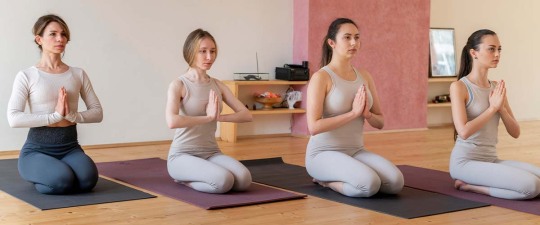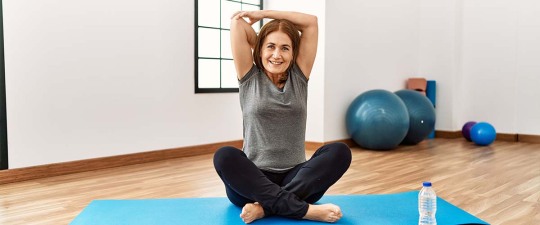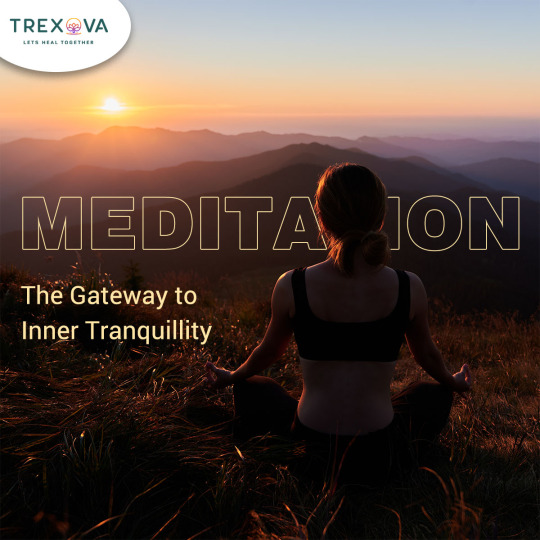Text
Wonders of Yoga: Enhance Your Well-being
In today's fast-paced world, where stress and anxiety seem to lurk around every corner, finding solace and peace of mind is essential. Yoga offers a pathway to tranquility, a means to rejuvenate both body and mind. Are you searching for a way to balance the chaos of life? Dive into the realm of online yoga class and experience the profound benefits firsthand.

Understanding Yoga
Yoga is not just a form of exercise; it's a lifestyle. Originating in ancient India, it encompasses physical postures, breathing exercises, and meditation techniques. At its core, yoga aims to unite the body, mind, and spirit, fostering a harmonious existence.
Benefits of Yoga
The benefits of yoga extend far beyond mere flexibility and strength. Regular practice can alleviate stress, improve concentration, and enhance overall well-being. Moreover, it promotes better sleep, boosts immunity, and cultivates a sense of inner peace.
Different Yoga Styles
Yoga is incredibly diverse, with various styles catering to different needs and preferences. Whether you prefer a gentle flow or an intense workout, there's a style for everyone. From Hatha to Vinyasa, Kundalini to Ashtanga, each style offers a unique experience.
Getting Started with Yoga
Embarking on a yoga journey can be intimidating, but it's simpler than you think. All you need is a mat, comfortable clothing, and an open mind. Start with poses that are suitable for beginners and advance at your own pace.
Importance of Online Classes
The popularity of online yoga classes has grown in the current digital era. They offer convenience, flexibility, and accessibility like never before. Whether you're a busy professional or a stay-at-home parent, you can reap the benefits of yoga from the comfort of your home.
Finding the Right Class
Choosing the best “online yoga classes near me” can be difficult with the abundance of options available. Consider factors such as the instructor's expertise, class duration, and style preference. Read reviews and testimonials to ensure a fulfilling experience.

Setting Up Your Space
Creating a conducive environment is crucial for a fulfilling yoga practice. Choose a place that is calm and clutter-free so that you can concentrate without being distracted. Enhance the ambiance with soft lighting, soothing music, and perhaps a touch of nature.
Tips for Beginners
It can be intimidating to start something new but don't let fear stop you. Have an open mind and an open heart as you embrace the journey. Listen to your body, practice patience, and celebrate progress, no matter how small.
Enhancing Your Practice
As you deepen your yoga practice, explore ways to challenge yourself and expand your horizons. Experiment with advanced poses, delve into meditation techniques, and explore the spiritual aspects of yoga.
Yoga for All Ages
Yoga knows no boundaries of age or fitness level. Whether you're young or young at heart, there's a practice suitable for you. From gentle chair yoga for seniors to playful sessions for kids, everyone can benefit from this ancient tradition.
Yoga and Mindfulness
Mindfulness is an integral aspect of yoga, emphasizing present-moment awareness and self-reflection. Through mindful yoga practice, you can cultivate a deeper connection with yourself and the world around you.
Conclusion
Yoga offers a pathway to holistic well-being, fostering harmony between the body, mind, and spirit. With the convenience and accessibility of online yoga classes, embarking on this transformative journey has never been easier. So, whether you're seeking stress relief, physical fitness, or inner peace, yoga awaits with open arms, ready to enrich your life in profound ways. Embrace the practice, and let its transformative power illuminate your path to a healthier, happier you.
FAQs
1. What equipment do I need for online yoga classes?
For online yoga classes, all you need is a yoga mat, comfortable clothing, and a stable internet connection. Optionally, props like blocks and straps can enhance your practice.
2. Can I practice yoga if I'm not flexible?
Absolutely! Flexibility is not a prerequisite for yoga. With regular practice, you'll gradually improve flexibility and mobility. Focus on listening to your body and honoring its limitations.
3. How often should I practice yoga?
The frequency of yoga practice varies from person to person. Aim for consistency rather than intensity. Even a short daily practice can yield significant benefits over time.
4. Are online yoga classes suitable for beginners?
Yes, many online yoga classes cater specifically to beginners. Look for introductory courses or sessions labeled as suitable for all levels. Don't hesitate to communicate with the instructor about your experience and any concerns.
5. Can yoga help with stress and anxiety?
Absolutely! Yoga is renowned for its stress-relieving properties. By incorporating breathwork, meditation, and mindful movement, yoga can significantly reduce stress and promote emotional well-being.
0 notes
Text
Unwind and Rejuvenate with Nearby Yoga Classes
Taking a moment to relax can be difficult in our hectic lives. That's where the practice of yoga comes in, offering a sanctuary for both mind and body. If you're seeking "nearby yoga classes" or "yoga classes near me only for ladies," this guide is for you. Just as a gardener tends to their plants with care, nurturing your well-being through yoga can help you bloom into your best self.

Types of Yoga Classes
Yoga is a vast practice with various styles catering to different needs and preferences. Here are some popular types of yoga classes you might encounter:
Hatha Yoga
Hatha Yoga is a gentle form of yoga that focuses on basic poses and breathing exercises. It's an excellent choice for beginners or those seeking a slower-paced class.
Vinyasa Flow
Vinyasa Flow, also known as power yoga, is a more dynamic and physically demanding style. It involves seamlessly transitioning between poses, creating a flow-like movement synchronized with breath.
Restorative Yoga
If you're seeking deep relaxation, Restorative Yoga might be the perfect fit. This style emphasizes gentle poses supported by props, allowing your body to release tension and promote healing.
Prenatal Yoga
Designed specifically for expectant mothers, Prenatal Yoga classes focus on poses and breathing techniques that can help alleviate discomfort and prepare for childbirth.
Benefits of Practicing Yoga
The benefits of yoga extend far beyond physical flexibility. Regular practice can positively impact both your body and mind.
Physical Benefits
Yoga can improve strength, balance, and flexibility, helping to prevent injuries and alleviate pain. It can also promote better posture, increase endurance, and support a healthy weight.
Mental Benefits
The mindfulness aspect of yoga can reduce stress and anxiety, promote relaxation, and cultivate a sense of inner peace. Additionally, it can improve concentration, boost self-confidence, and enhance overall well-being.
Finding the Right Yoga Studio
With numerous yoga studios to choose from, finding the right fit can be daunting. Consider these factors when exploring "nearby yoga classes":
Location and Convenience
Choosing a studio close to your home or workplace can make it easier to stick to a consistent practice. Look for studios with convenient class schedules that align with your availability.
Instructor Qualifications
Experienced and knowledgeable instructors can guide you through proper alignment and modifications, ensuring a safe and effective practice. Research the instructors' backgrounds and teaching styles.
Class Schedules and Pricing
Evaluate the class schedules to find options that suit your preferences and commitment level. Additionally, consider the pricing and any package deals or membership options that may be more cost-effective.

Preparing for Your First Yoga Class
To ensure a comfortable and enjoyable experience, it's essential to prepare adequately for your first yoga class. Here are some tips:
What to Wear
Opt for comfortable, breathable clothing that allows for free movement. Avoid loose or baggy items that may hinder your practice.
Bringing the Right Equipment
While most studios provide mats, bringing your own can be more hygienic. You may also want to carry a towel and water bottle.
Setting Realistic Expectations
Yoga is a journey, and it's essential to be patient and kind to yourself. Don't compare your ress to others, and remember that consistency is key to seeing results.
Embracing the Yoga Lifestyle
While attending "nearby yoga classes" is a great start, embracing the yoga lifestyle can amplify the benefits and deepen your practice.
Mindful Eating
Yoga encourages mindfulness, which can extend to your eating habits. Consider incorporating more whole, plant-based foods into your diet and practicing conscious eating.
Meditation and Breathwork
Many yoga classes incorporate meditation and breathwork techniques. Continuing these practices off the mat can cultivate greater mindfulness and stress relief.
Self-Reflection and Gratitude
Yoga teaches us to look inward and appreciate the present moment. Make time for self-reflection and cultivate a sense of gratitude for the journey you're on.
Conclusion
Incorporating "nearby yoga classes" into your routine can be a transformative experience, offering numerous physical, mental, and emotional benefits. Whether you're seeking a gentle practice or a more challenging workout, there's a yoga style suited for you. Embrace the journey, stay curious, and enjoy the process of discovering your inner strength and peace.
FAQs
1. Can I attend yoga classes if I have no prior experience?
Absolutely! Most studios offer beginner-friendly classes designed to introduce the fundamentals of yoga. Don't hesitate to communicate your experience level with the instructor.
2. Are there any age restrictions for attending yoga classes?
Yoga is suitable for people of all ages. Many studios offer specialized classes for children, seniors, and everything in between.
3. Do I need to be flexible to practice yoga?
Not at all! Yoga is not about being flexible from the start but about gradually improving your flexibility over time. The practice meets you where you are and guides you on a journey of self-discovery.
4. Can yoga help with specific health conditions?
Yoga has been shown to offer therapeutic benefits for various health conditions, including chronic pain, anxiety, depression, and more. However, it's always advisable to consult with a healthcare professional before starting a new exercise regimen.
5. How often should I attend yoga classes?
The frequency of your practice will depend on your goals and schedule. Most experts recommend practicing yoga at least twice a week for noticeable benefits, but even one class per week can be beneficial for beginners
0 notes
Text
Panchakarma Treatment: Detoxify and Rebalance
Have you been feeling run down, sluggish, or just out of sync lately? If so, it might be time to hit the reset button with a panchakarma treatment. This ancient Ayurvedic detoxification ritual has been revitalizing minds and bodies for centuries, and its holistic approach could be just what you need to get your groove back.
In our fast-paced, modern world, it's easy to accumulate physical and mental toxins that can leave us feeling drained and imbalanced. That's where panchakarma comes in - a comprehensive mind-body cleanse that flushes out those pesky impurities and restores harmony. Imagine hitting the refresh button on your entire system!

What is Panchakarma Treatment?
At its core, panchakarma (pronounced "pun-cha-kar-maa") is a collection of five purification therapies designed to eliminate deep-seated toxins from the mind and body. This detoxification process aims to restore balance to the three doshas - vata, pitta, and kapha - which govern all physiological activities according to Ayurvedic principles.
The Five Purification Therapies
The magic of panchakarma lies in its multifaceted approach, employing five distinct yet complementary therapies:
Vamana (Therapeutic Vomiting)
This controlled purging technique helps eliminate toxins from the respiratory and digestive systems.
Virechana (Purgation Therapy)
Virechana uses therapeutic laxatives to flush out toxins from the gastrointestinal tract and bloodstream.
Basti (Enema Therapy)
This ancient form of enema helps cleanse the colon and optimize nutrient absorption.
Nasya (Nasal Administration)
By administering herbal oils and powders through the nose, nasya clears toxins from the head and sinus region.
Raktamokshana (Blood Detoxification)
As the name suggests, this therapy purifies the blood through methods like bloodletting or leeching.
Pre-Panchakarma: Prepping Mind & Body
Before embarking on the panchakarma journey, it's crucial to prepare both mind and body. This preparatory phase, known as purvakarma, may involve dietary changes, herbal supplements, and lifestyle adjustments to prime your system for the upcoming cleanse.
The Panchakarma Process
The panchakarma process itself is a multi-day (often multi-week) affair, with each day bringing a new combination of therapies tailored to your specific needs. Expect a variety of treatments like oil massages, herbal steams, and medicated enemas, all administered by skilled Ayurvedic practitioners.
Post-Panchakarma: Aftercare & Integration
Once the intensive cleanse is complete, the post-panchakarma phase focuses on slowly reintroducing a balanced diet, supplements, and lifestyle practices to help integrate and sustain the benefits of the treatment. Think of it as gently easing back into your routine, but with a renewed sense of vitality.

Benefits of Panchakarma
Beyond the obvious perk of flushing out accumulated toxins, panchakarma offers a host of potential benefits, including:
- Improved digestion and metabolism
- Boosted immune function
- Enhanced mental clarity and focus
- Reduced stress and anxiety
- Increased energy levels
- Relief from chronic conditions like arthritis, skin issues, and more
Who Can Benefit from Panchakarma?
While panchakarma can benefit virtually anyone seeking a full-body reset, it's particularly useful for those dealing with chronic health issues, high-stress lifestyles, or a general feeling of being out of balance. However, certain conditions may preclude specific therapies, so it's essential to consult with a qualified practitioner.
Finding a Qualified Practitioner
Speaking of practitioners, it's crucial to entrust your panchakarma journey to experienced, well-trained professionals. Look for Ayurvedic clinics or centers with a solid reputation, and don't hesitate to ask about the practitioners' qualifications and experience.
Panchakarma vs. Other Detox Methods
Unlike many modern detox fads that rely on restrictive diets or extreme fasting, panchakarma takes a gentler, more holistic approach. Rather than shocking the system, it gradually and systematically eliminates toxins while nourishing the body with herbal treatments and personalized dietary recommendations.
The Panchakarma Experience
Admittedly, the prospect of voluntary vomiting or enemas might seem a bit daunting at first. But those who have experienced panchakarma often liken it to hitting the reset button on their entire being. Imagine emerging from this ancient ritual feeling lighter, brighter, and more in tune with yourself – like shedding layers of accumulated grime to reveal your true, radiant essence.
Conclusion
In our relentless pursuit of health and wellbeing, panchakarma offers a time-honored solution for detoxifying the mind, body, and spirit. By embracing this comprehensive cleanse, you're not just purging physical toxins but also creating space for renewed vitality, balance, and inner harmony. So why not take that first step toward rejuvenation and find a 'panchakarma treatment near me' today?
Frequently Asked Questions (FAQs)
Q1: Is panchakarma safe for everyone?
While panchakarma is generally considered safe when performed by qualified practitioners, certain conditions or medications may contraindicate specific therapies. It's essential to disclose your full medical history and consult with an experienced Ayurvedic doctor before proceeding.
Q2: How often should I undergo panchakarma?
The recommended frequency of panchakarma treatments varies based on individual needs and circumstances. Most practitioners suggest undergoing a full panchakarma cleanse annually or bi-annually, with shorter treatments (like basti or nasya) incorporated more frequently as needed.
Q3: Can I continue my regular activities during panchakarma?
During the intensive cleanse phase of panchakarma, it's advisable to minimize physical and mental exertion to allow your body to fully focus on the detoxification process. However, light activities like gentle yoga or meditation may be recommended.
Q4: How long does the entire panchakarma process take?
The duration of a complete panchakarma treatment can range from a few days to several weeks, depending on the specific therapies involved and the severity of your imbalances. Your Ayurvedic practitioner will develop a customized plan based on your individual needs.
0 notes
Text
Vipassana vs. Transcendental Meditation: Different Paths to Inner Peace
In today's fast-paced world, where stress and anxiety seem ever-present, many individuals seek solace in ancient practices that promise inner peace and harmony. Two such practices, vipassana meditation and transcendental meditation, have gained immense popularity. While both offer a gateway to tranquility, they differ in their approaches and philosophies.
In this article, we'll delve into the intricacies of these two meditation techniques, exploring their similarities, contrasts, and ultimately, their shared pursuit of inner peace. Fasten your seatbelts as we embark on a journey of self-discovery and enlightenment.

Introduction to Vipassana Meditation
Vipassana meditation, also known as Insight Meditation, is an ancient Buddhist practice that emphasizes the cultivation of mindfulness and self-awareness. Its roots can be traced back to the teachings of the Buddha himself, and it has been practiced for centuries in countries like India, Sri Lanka, and Thailand.
The Art of Observing the Present Moment
At its core, vipassana encourages practitioners to observe their thoughts, emotions, and physical sensations with a non-judgmental mindset. By developing this acute awareness, individuals can gain a deeper understanding of their inner selves and ultimately break free from the cycles of suffering and dissatisfaction.
The Transcendental Meditation Technique
Transcendental Meditation (TM) is a practice that originated in India and was popularized in the West by Maharishi Mahesh Yogi in the 1950s. Unlike vipassana, which focuses on mindfulness and observation, TM involves the repetition of a personal mantra, or a specific sound or word, to achieve a state of transcendental consciousness.
Effortless Transcendence
Proponents of TM believe that by silently repeating the mantra during meditation, the mind naturally settles into a state of pure awareness, transcending the boundaries of thought and attaining a profound sense of relaxation and inner peace.
The Contrasts between Vipassana and Transcendental Meditation
Despite their shared goal of inner tranquility, vipassana and transcendental meditation diverge in their approaches and philosophies.
Technique
Vipassana practitioners focus on observing the present moment, including their thoughts, emotions, and physical sensations, without judgment or attachment. In contrast, TM practitioners use a personal mantra as a tool to transcend the mind's activity and reach a state of pure consciousness.
Tradition and Lineage
Vipassana has its roots in the ancient Buddhist tradition, tracing its origins back to the teachings of the Buddha himself. On the other hand, TM was introduced and popularized in the 20th century by Maharishi Mahesh Yogi, although it draws upon the Vedic tradition of India.
Approach to Thoughts and Emotions
In vipassana, practitioners are encouraged to observe their thoughts and emotions impartially, without suppressing or indulging them. TM, however, aims to transcend the mind's activity altogether, using the mantra as a tool to settle the mind into a state of pure consciousness.

The Common Ground: Seeking Inner Peace
Despite their differences, both vipassana and transcendental meditation share a common goal: the attainment of inner peace, clarity, and a sense of well-being. Like two paths leading to the same destination, these practices offer individuals the opportunity to cultivate a greater sense of calm and contentment in their lives.
Reducing Stress and Anxiety
Numerous studies have shown that both vipassana and transcendental meditation can effectively reduce stress and anxiety levels, promoting a more balanced and harmonious state of mind. As the mind becomes more tranquil, individuals may experience improved focus, concentration, and overall well-being.
Enhancing Self-Awareness and Mindfulness
While the techniques differ, both practices ultimately lead to a heightened sense of self-awareness and mindfulness. By becoming more attuned to their inner experiences, individuals can gain valuable insights into their thought patterns, emotional responses, and habitual behaviors, paving the way for personal growth and transformation.
The Journey Inward: Finding the Right Path
Choosing between vipassana and transcendental meditation is a personal decision that should align with one's individual preferences, beliefs, and aspirations. Some may resonate more with the mindfulness-based approach of vipassana, while others may find the effortless transcendence of TM more appealing.
Seeking Guidance and Support
Regardless of the path chosen, it is often helpful to seek guidance from experienced teachers or practitioners, especially in the early stages of the practice. Many vipassana meditation centres and TM organizations offer structured courses and ongoing support to ensure a solid foundation and proper understanding of the techniques.
The Ripple Effect: Benefits Beyond the Individual
The benefits of vipassana and transcendental meditation extend beyond the individual practitioner, rippling outwards and positively impacting relationships, communities, and society as a whole.
Cultivating Compassion and Understanding
By cultivating a deeper sense of self-awareness and empathy, practitioners of both vipassana and transcendental meditation may become more attuned to the experiences of others, fostering a greater sense of compassion and understanding in their interactions.
Contributing to a More Peaceful Society
As individuals find inner peace and harmony through these practices, they may become agents of change, radiating a sense of calm and positivity that can inspire others to embrace a more mindful and compassionate way of living, ultimately contributing to a more peaceful and harmonious society.
Conclusion
Whether one chooses the path of vipassana meditation or transcendental meditation, the pursuit of inner peace is a noble and rewarding journey. Both practices offer profound insights and techniques for cultivating a state of tranquility, clarity, and well-being.
As we navigate the complexities of modern life, it is comforting to know that ancient wisdom and practices like these can serve as beacons, guiding us towards a more balanced and fulfilling existence. Embrace the journey inward, and may you find the peace and serenity you seek, regardless of the path you choose.
FAQs
1. Can beginners practice both vipassana and transcendental meditation?
While it is possible to practice both techniques, it is generally recommended for beginners to focus on one practice at a time to develop a solid foundation and avoid confusion or conflicts between the two approaches. Seeking guidance from experienced teachers is highly advisable.
2. How long does it take to experience the benefits of vipassana and transcendental meditation?
The timeframe can vary from individual to individual, as it depends on factors such as consistency, dedication, and individual circumstances. However, many practitioners report experiencing positive effects, such as reduced stress and increased calmness, within a few weeks or months of regular practice.
3. Are there any contraindications or precautions for practicing vipassana or transcendental meditation?
Both practices are generally considered safe for most individuals. However, it is advisable to consult a healthcare professional, especially if you have a history of mental health conditions or are undergoing medical treatment, to ensure the practice is suitable for your specific circumstances.
4. Can these practices be combined with other forms of meditation or spiritual practices?
While it is possible to incorporate elements from various practices, it is essential to approach them with care and guidance from experienced teachers to avoid potential conflicts or confusion. Maintaining the integrity and traditional teachings of each practice is crucial.
5. How can I find a reputable Vipassana meditation centre or transcendental meditation program?
Conduct thorough research and seek recommendations from trusted sources or experienced practitioners. Many established organizations and centers offer structured programs and ensure proper guidance and teachings from qualified instructors.
0 notes
Text
Ayurvedic Healing for Arthritis: Your Path to Pain Relief
Arthritis, the persistent inflammation of joints, can be a debilitating condition that affects millions worldwide. If you're among those seeking relief from the arthritis treatment in ayurveda, the ancient Indian system of medicine offers a holistic and natural approach. Imagine a world where you can bid farewell to chronic pain and embrace a life of vitality – that's the promise of Ayurvedic healing for arthritis. In this comprehensive guide, we'll uncover the power of Ayurvedic remedies, explore the best Ayurvedic centre near you, and provide you with the tools to reclaim your well-being.

Understanding Arthritis Through the Ayurvedic Lens
According to Ayurveda, arthritis is often linked to an imbalance of the three doshas – Vata, Pitta and Kapha. These energetic forces govern various bodily functions and when they are out of sync, it can lead to joint inflammation, pain and stiffness. Ayurveda aims to restore this delicate balance, addressing the root cause rather than merely suppressing symptoms.
The Ayurvedic Approach to Arthritis Management
Diet and Lifestyle Modifications
Ayurveda places great emphasis on a wholesome diet and lifestyle adjustments. By consuming anti-inflammatory foods like turmeric, ginger and certain seasonal fruits and vegetables, you can naturally reduce inflammation and nourish your joints. Simultaneously, practicing gentle exercises like yoga and incorporating stress-management techniques can significantly alleviate arthritis symptoms.
Herbal Remedies and Supplements
Ayurvedic practitioners may recommend a personalized blend of herbal remedies and supplements to address your specific needs. For instance, Shallaki (Boswellia serrata) and Guggulu (Commiphora mukul) are renowned for their anti-inflammatory properties, while Ashwagandha (Withania somnifera) can bolster the body's natural defenses against arthritis.
Panchakarma: The Ultimate Detox
For more severe cases, Ayurvedic centers may suggest Panchakarma, a series of detoxification therapies designed to eliminate toxins (ama) from the body. This comprehensive cleansing process can involve therapies like Abhyanga (Ayurvedic massage), Shirodhara (gentle pouring of warm oils on the forehead) and Virechan (therapeutic purgation).

Finding the Right Ayurvedic Centre Near Me
Evaluating Expertise and Credentials
When searching for an "ayurvedic centre near me", it's crucial to assess the expertise and credentials of the practitioners. Look for centers staffed by experienced Ayurvedic doctors (BAMS or equivalent) and therapists trained in authentic Ayurvedic practices.
Personalized Treatment Plans
A reputable Ayurvedic center will develop a personalized treatment plan tailored to your unique constitution (Prakriti) and the specific nature of your arthritis. This holistic approach ensures that you receive the most effective and targeted care.
Complementing Ayurveda with Modern Medicine
While Ayurveda offers a natural and holistic approach, it can also complement modern medical treatments for arthritis. Many individuals find success by integrating Ayurvedic therapies with conventional pain management techniques, under the guidance of qualified professionals.
Conclusion
Arthritis need not be a life sentence of unrelenting pain and discomfort. Ayurvedic healing offers a holistic, natural pathway to relief through its multi-pronged approach of diet adjustments, herbal remedies, detoxification practices, and mindful lifestyle changes. By seeking expertise at reputable ayurvedic centres near you and committing to this ancient system of medicine, you can embark on a transformative journey towards reclaiming your vitality and bidding farewell to the unrelenting pain of arthritis. Embrace Ayurveda with patience and dedication, and let the harmonious balance of mind, body, and spirit guide you to a life where pain is no longer the norm.
Frequently Asked Questions (FAQs)
1. How long does it take for Ayurvedic treatments to show results for arthritis?
While individual experiences may vary, many people report noticeable improvements within a few weeks to months of consistent Ayurvedic therapy. However, it's essential to be patient and follow your practitioner's guidance.
2. Are Ayurvedic remedies safe for long-term use?
Yes, when properly administered by qualified Ayurvedic practitioners, these natural remedies are generally considered safe for long-term use. However, it's always advisable to consult with your healthcare provider, especially if you have any underlying medical conditions.
3. Can Ayurveda cure arthritis completely?
Ayurveda aims to manage and alleviate the symptoms of arthritis through holistic means. While complete remission is possible in some cases, the primary goal is to improve overall well-being and quality of life.
4. Are there any side effects associated with Ayurvedic treatments for arthritis?
Mild side effects like digestive discomfort or skin rashes may occur in some individuals, particularly during the initial stages of treatment. However, these are typically temporary and can be managed under the guidance of an experienced Ayurvedic practitioner.
5. Can Ayurvedic therapies be combined with conventional arthritis medications?
Yes, Ayurvedic treatments can often be integrated with conventional medications, but it's essential to consult with both your Ayurvedic practitioner and your healthcare provider to ensure safe and effective coordination of therapies.
By embracing the ancient wisdom of Ayurveda and seeking guidance from a reputable ayurvedic centre near me, you can embark on a transformative journey towards lasting relief from arthritis pain. Remember, the path to healing is a holistic one, encompassing mind, body and spirit. Embrace the principles of Ayurveda and you may just unlock the key to a life free from the shackles of arthritis.
0 notes
Text
Zumba Fever: Dance Your Way to Fitness
Are you sick of doing the same old exercises every day? Searching for a thrilling and enjoyable method to lose weight? Look no further than Zumba classes near me! This high-energy dance craze has taken the world by storm, and for good reason. Imagine a party-like atmosphere where you can shake your booty while shedding pounds and toning your body. Sound too good to be true? Explore the world of Zumba with me as we dive right in!

What is Zumba?
A High-Energy Dance Party
Zumba is a high-energy dance fitness program that combines Latin and international rhythms with easy-to-follow choreography. Imagine stepping into a party atmosphere where the music is pumping, and everyone is moving to the beat. It's a full-body cardio workout that feels more like a celebration than exercise.
The Benefits of Zumba
A Full-Body Workout
Zumba targets every major muscle group, providing a comprehensive workout for your entire body. From your arms and shoulders to your core and legs, you'll feel the burn as you groove to the beat. But don't worry; the music and atmosphere will keep you motivated and energized throughout the class.
Stress Relief and Mental Boost
Beyond the physical benefits, Zumba offers a much-needed mental break from the stresses of daily life. As you immerse yourself in the rhythms and lose yourself in the movements, you'll experience a sense of joy and freedom that can boost your mood and mental well-being.
What to Expect in a Zumba Class
The Zumba Playlist
Zumba classes feature a carefully curated playlist of high-energy, rhythmic tunes from various genres, including salsa, merengue, reggaeton, and more. The music is the driving force behind the movements, so be prepared to let loose and move to the beat.
Choreography and Moves
While Zumba may seem intimidating at first, the choreography is designed to be easy to follow, even for beginners. Instructors break down the moves step-by-step, allowing you to gradually build up your confidence and skill level. Don't be afraid to make mistakes – the key is to keep moving and have fun!
Preparing for Your First Zumba Class
Dress for Success
Comfortable and breathable clothing is essential for a successful Zumba experience. Opt for moisture-wicking fabrics and supportive shoes with good traction to prevent slips and injuries. Remember, you'll be moving a lot, so dress for the occasion.
Hydration and Nutrition
Zumba is a high-intensity workout, so it's crucial to stay hydrated throughout the class. Bring a water bottle and sip regularly to replenish lost fluids. Additionally, fueling your body with nutritious snacks before and after class can help you maintain your energy levels and support muscle recovery.

Zumba for All Levels
Beginner-Friendly Classes
If you're new to Zumba, don't worry! Many studios offer beginner-friendly classes designed to introduce you to the basics and help you build confidence. These classes move at a slower pace and focus on mastering the foundational steps and rhythms.
Advanced Zumba Challenges
As you progress in your Zumba journey, you can explore more advanced classes that incorporate challenging choreography, higher intensity levels, and additional fitness elements like strength training or HIIT intervals. These classes are perfect for seasoned Zumba enthusiasts looking to take their workouts to the next level.
Zumba for Weight Loss and Toning
While Zumba is primarily a cardio-based workout, it can also be an effective tool for weight loss and toning. The high-intensity intervals and full-body movements help burn calories and build lean muscle. Combine regular Zumba classes with a balanced diet, and you'll be well on your way to achieving your fitness goals.
Finding Zumba Classes
Joining a Local Studio
One of the best ways to experience Zumba is by joining a local studio or gym that offers classes. Search for "Zumba near me" online or ask around for recommendations. Attending in-person classes allows you to feed off the energy of the group and receive guidance from a certified Zumba instructor.
Online Classes: Zumba from Home
Can't make it to a studio? No problem! Thanks to the wonders of technology, you can now access Zumba from the comfort of your own home. Many instructors and platforms offer online classes, allowing you to join the party no matter where you are.
Conclusion
Zumba is more than just a workout; it's a celebration of life, music, and movement. By joining the Zumba craze, you'll embark on a journey of self-discovery, improved physical and mental well-being, and a whole lot of fun! So, what are you waiting for? Grab your dancing shoes, let loose, and join the party.
Frequently Asked Questions (FAQs)
Is Zumba suitable for beginners?
Absolutely! Zumba is designed for all fitness levels, and instructors provide modifications and guidance to help newcomers feel comfortable and confident.
Can Zumba help me lose weight?
Yes, Zumba is an excellent calorie-burning workout. When combined with a balanced diet and active lifestyle, it can aid in weight loss and overall health improvement.
Do I need to be a good dancer to do Zumba?
Not at all! Zumba is all about letting loose and having fun. The moves are designed to be easy to follow, and instructors break them down step-by-step.
Can I do Zumba if I have joint issues or injuries?
Many Zumba variations, like Aqua Zumba and Zumba Gold, are low-impact and easy on the joints. However, it's always best to consult your healthcare provider before starting any new exercise program.
0 notes
Text
Yoga for Diabetes: Simple Practices for Better Health
Have you been searching for the best yoga classes near me to help manage your diabetes? Look no further! Yoga offers a holistic approach to improving overall health, including managing diabetes. In this article, we'll explore simple yoga for diabetes practices specifically designed for individuals with diabetes. Whether you're a seasoned yogi or a beginner, these accessible techniques can help you unlock better health and find a renewed sense of balance. Just like a soothing melody calms the mind, yoga's gentle movements and breathing exercises can harmonize your body, reducing the impact of this chronic condition.

Understanding Diabetes and Yoga's Benefits
How Yoga Helps Manage Diabetes
Diabetes is a long-term illness that alters your body's ability to metabolise glucose or blood sugar. While medication and diet play a crucial role in managing diabetes, incorporating yoga into your routine can offer numerous benefits. Yoga asanas help reduce blood sugar, increase insulin sensitivity and aid in weight loss. Additionally, deep breathing exercises (pranayama) and meditation reduce stress, a significant contributor to diabetes complications.
Simple Yoga Poses for Diabetes Management
Standing Poses
Standing poses, such as Mountain Pose (Tadasana) and Tree Pose (Vrksasana), strengthen your legs and improve balance. These poses also engage your core muscles, aiding digestion and improving insulin sensitivity.
Seated Poses
Seated poses like Bound Angle Pose (Baddha Konasana) and Head-to-Knee Forward Bend (Janu Sirsasana) are gentle yet effective in improving flexibility and promoting better blood circulation.
Lying Poses
Lying poses, such as Supine Spinal Twist (Supta Matsyendrasana) and Legs-Up-the-Wall Pose (Viparita Karani), reduce stress and improve blood flow, which is crucial for managing diabetes.
Breathing Techniques for Diabetes Control
Pranayama and Its Impact
Pranayama, or yogic breathing exercises, play a vital role in diabetes management. Practices like Alternate Nostril Breathing (Nadi Shodhana) and Bee Breath (Bhramari Pranayama) can lower blood pressure, reduce stress and improve overall well-being.
The Mind-Body Connection: Meditation and Diabetes
Stress Reduction and Mindfulness
Diabetes can be a stressful condition and stress can further exacerbate the symptoms. Meditation, an integral part of yoga, promotes mindfulness and reduces stress levels, leading to better diabetes management. Practices like breath awareness and body scans can cultivate a sense of calm and balance.

Incorporating Yoga into Your Routine
Finding the Best Yoga Classes Near You
To get started with yoga for diabetes, consider finding a qualified instructor who understands your specific needs. Search for “best yoga classes near me” or consult your healthcare provider for recommendations on suitable classes or studios.
At-Home Yoga Practice
If attending classes is not feasible, you can practice yoga at home. Many online resources and mobile apps provide guided yoga sessions tailored for diabetes management, making it convenient to incorporate yoga into your daily routine.
Precautions and Tips for Yoga with Diabetes
While yoga is generally safe, individuals with diabetes should take certain precautions. Always consult your healthcare provider before starting a new exercise regimen, especially if you have complications like neuropathy or retinopathy. Stay hydrated, monitor your blood sugar levels and avoid poses that strain your body excessively.
Conclusion
Yoga offers a holistic approach to managing diabetes and promoting physical, mental and emotional well-being. By incorporating simple yet powerful yoga practices into your routine, you can improve insulin sensitivity, reduce stress and cultivate a more balanced lifestyle. Whether you attend "best yoga classes" near you or practice at home, embrace the mind-body connection and experience the transformative benefits of yoga for diabetes.
FAQs
1. Can yoga help reverse diabetes?
While yoga cannot directly reverse diabetes, it can help manage the condition by improving insulin sensitivity, promoting weight loss and reducing stress, which are all crucial factors in diabetes management.
2. Is yoga safe for people with diabetes-related complications?
Yoga is generally safe, but individuals with diabetes-related complications like neuropathy or retinopathy should consult their healthcare provider and take necessary precautions before starting a yoga practice.
3. How often should I practice yoga for diabetes management?
Ideally, aim for at least 3-4 sessions per week, with each session lasting 30-60 minutes. Consistency is key to experiencing the full benefits of yoga for diabetes management.
4. Can I practice yoga if I'm not flexible?
Absolutely! Yoga is not just about flexibility; it's about creating a mind-body connection and embracing the journey. With regular practice, you will gradually improve your flexibility and reap the benefits of yoga for diabetes management.
5. What's the best time to practice yoga for diabetes management?
While there's no definitive best time, many practitioners find morning or evening sessions beneficial. Choose a time that works best for your schedule and allows you to practice yoga without rushing or stress.
0 notes
Text
Beyond Fad Diets: Building a Healthy Lifestyle
Have you ever felt overwhelmed by the endless cycle of fad weight loss diet trends promising miraculous results? The truth is, that sustainable health goes beyond temporary quick fixes. It's time to ditch the fad mentality and embrace a holistic approach that nurtures your body, mind and overall well-being. Just like building a strong foundation for a house, cultivating a healthy lifestyle requires patience, commitment and a deep understanding of what truly nourishes you.
In this article, we'll explore practical strategies to move beyond the fad diet trap and embark on a journey toward lasting wellness. Whether you're seeking a tailored diet for diabetic patients or a reliable diet for weight loss for females, the principles we'll discuss will guide you toward making informed choices that align with your unique needs and goals.

Understand Your Body's Needs
The first step towards building a healthy lifestyle is to understand your body's unique needs. Since each person is unique, what works for one might not work for another. Listen to your body's signals, such as hunger cues, energy levels and digestive responses. Additionally, consulting health professionals, such as registered dietitians or certified nutritionists, can provide personalized guidance tailored to your specific circumstances.
Embrace a Balanced Approach
A balanced diet is the cornerstone of a healthy lifestyle. Macronutrients (proteins, carbohydrates and healthy fats) are the building blocks that provide energy and essential nutrients. Micronutrients (vitamins, minerals and antioxidants) are the hidden heroes that support various bodily functions. Aim for a diverse array of whole, minimally processed foods to meet your nutritional needs.
Mindful Eating Habits
Cultivating mindful eating habits is crucial for sustainable lifestyle changes. Portion control is crucial to avoiding overindulging and maintaining a healthy weight. Additionally, take the time to savor the experience of eating by engaging your senses and practicing mindfulness during mealtimes.
Hydration: The Overlooked Essential
Proper hydration is often overlooked but plays a vital role in overall health. Aim to drink an adequate amount of water throughout the day to support various bodily functions, including digestion, nutrient absorption and cognitive performance.
Physical Activity: Move Your Body
Maintaining a healthy weight, enhancing cardiovascular health and improving general wellbeing all depend on regular physical activity. Find activities you enjoy, whether it's dancing, hiking, or swimming, to make exercise a sustainable part of your lifestyle. Additionally, incorporate strength training to build and maintain lean muscle mass, which can boost metabolism and support weight management.
Stress Management: A Crucial Component
Stress can negatively affect both mental and physical health, and it frequently triggers unhealthy coping strategies like emotional eating or skipping self-care. Practice mindfulness techniques, such as deep breathing exercises or meditation, to manage stress effectively. Furthermore, prioritize self-care activities that bring you joy and relaxation, such as reading, taking a warm bath, or engaging in a hobby you love.

Personalized Approach for Diabetic Patients
When it comes to managing diabetes, a diet for diabetic patients plays a crucial role in stabilizing blood sugar levels and promoting overall health. Focus on balancing carbohydrates, protein, and healthy fats to prevent spikes in blood sugar and maintain energy levels throughout the day. Choose whole, unprocessed foods like fruits, vegetables, lean proteins and whole grains, which are rich in fiber and nutrients. Avoid sugary beverages and processed snacks, opting instead for water and homemade snacks to keep blood sugar levels in check. Consistency is key, so aim to spread out meals and snacks evenly throughout the day and monitor your blood sugar levels regularly. With mindful food choices and careful planning, you can effectively manage your diabetes and enjoy a balanced, fulfilling diet.
Tailoring Plans for Female Weight Loss
When it comes to diet for weight loss for females, it's essential to focus on nourishing your body with nutrient-dense foods while creating a sustainable eating plan. Instead of restrictive diets that leave you feeling deprived, aim for a balanced intake of whole grains, lean proteins, fruits, vegetables and healthy fats. Incorporating regular meals and snacks throughout the day can help stabilize blood sugar levels and prevent overeating. Remember, sustainable weight loss is about making gradual, lasting changes to your eating habits rather than quick fixes or drastic measures. By prioritizing nourishment and listening to your body's hunger and fullness cues, you can achieve your weight loss goals while supporting your overall health and well-being.
Sustainable Lifestyle Changes
Lasting change doesn't happen overnight. Set realistic goals that align with your priorities and lifestyle. Celebrate small wins along the way, as these milestones will keep you motivated and focused on your journey. Remember, building a healthy lifestyle is a marathon, not a sprint.
Building a Support System
Surrounding yourself with a supportive network can make a significant difference in your journey towards a healthier lifestyle. Seek encouragement from friends, family, or join local support groups or online communities. Having a solid support system can provide accountability, motivation, and a sense of camaraderie as you navigate through challenges and celebrate successes together.
Conclusion
The path to true wellness lies in embracing a holistic approach that goes beyond fad diets. By understanding your body's needs, embracing balanced nutrition, practicing mindful habits, managing stress, and engaging in regular physical activity, you'll be well on your way to building a sustainable, wholesome way of living that feeds your body, mind and spirit.
FAQs
1. How can I stay motivated on my healthy lifestyle journey?
Setting achievable goals, celebrating small wins, and surrounding yourself with a supportive network can help maintain motivation and prevent burnout on your journey towards a healthier lifestyle.
2. Can I still enjoy my favorite foods while following a healthy lifestyle?
Absolutely! The key is to practice moderation and balance. Deprivation often leads to cravings and potential binge episodes. Incorporate your favorite foods in moderation and focus on making nutritious choices most of the time.
3. How much physical activity is recommended for optimal health?
The recommended guidelines for adults are at least 150 minutes of moderate-intensity aerobic activity or 75 minutes of vigorous-intensity aerobic activity per week, in addition to strength training activities focusing on all major muscle groups for two or more days.
4. Can a healthy lifestyle help manage chronic conditions like diabetes?
Yes, adopting a healthy lifestyle that includes a balanced diet, regular physical activity, and effective stress management can significantly improve the management of chronic conditions like diabetes, reducing the risk of complications and improving overall quality of life.
5. Is it necessary to follow a specific diet plan for weight loss as a female?
While there are no one-size-fits-all solutions, tailoring your approach to accommodate hormonal changes and prioritizing strength training can be beneficial for sustainable weight loss and overall health for females. Consulting a qualified healthcare professional can help you develop a personalized plan.
0 notes
Text
Journey of Serenity: Yoga Classes for Women
In the fast-paced world we live in, finding solace and balance can be a challenging feat. Amidst the hustle and bustle, have you ever yearned for a sanctuary where you can reconnect with your mind, body, and soul? Look no further than the world of yoga, a timeless practice that has been transforming lives for centuries. Whether you're a seasoned yogi or a curious beginner, exploring online yoga class, or yoga classes near me only for ladies can be the doorway to a more harmonious existence.

The Art of Mindfulness
In our fast-paced world, where distractions abound and the mind is constantly racing, the practice of mindfulness has become a coveted respite. Yoga, at its core, is a meditation in motion, allowing you to cultivate a heightened state of awareness and presence. As you synchronize your breath with each asana (yoga posture), you'll find yourself becoming more grounded in the present moment, letting go of the weight of the past and the uncertainty of the future.
Flexibility: A Journey Within
One of the most visible benefits of yoga is the enhanced flexibility it bestows upon its practitioners. However, this journey is not merely physical; it's a metaphor for the malleability of the mind and spirit. As you gently push your boundaries and embrace new depths of stretch, you'll discover that the true flexibility lies within – the ability to adapt, to grow, and to embrace change with grace.
Unleash Your Inner Strength
Contrary to popular belief, yoga is not just about bending and stretching; it's a celebration of strength, both physical and mental. Each pose challenges you to engage your core muscles, building a foundation of stability and balance. But the true strength lies in your determination, your perseverance, and your ability to push through the discomfort, emerging stronger and more resilient than ever before.
Discovering Nearby Yoga Studios
One of the first steps in your yoga journey is finding the perfect studio that resonates with your needs and preferences. Explore yoga classes near me by utilizing online directories or asking for recommendations from friends and family. A cozy, welcoming atmosphere can make all the difference in your experience, allowing you to fully immerse yourself in the practice.
The Convenience of Online Classes
In today's digital age, the world of yoga has embraced the convenience of online yoga classes. Whether you're short on time, prefer the comfort of your own space, or live in an area with limited studio options, virtual classes offer a flexible solution. With a plethora of platforms and instructors to choose from, you can tailor your practice to suit your schedule and preferences.
Ladies-Only Classes: A Safe Haven
For many women, the idea of practicing yoga in a women-only environment holds a special appeal. So by searching “Yoga classes near me only for ladies” will provide a safe and empowering space where you can let go of societal pressures and embrace your authentic self. In this nurturing environment, you can freely explore your boundaries, build confidence, and forge bonds with like-minded individuals.

Choosing the Right Style
Yoga is a multi-faceted practice, with various styles catering to different needs and preferences. From the gentle and restorative practices of Hatha and Yin Yoga to the more dynamic and physically challenging styles like Vinyasa and Ashtanga, take the time to explore and find the one that resonates with your goals and desired intensity level.
Preparing for Your First Class
As you embark on your yoga journey, it's natural to feel a mix of excitement and apprehension. To ensure a comfortable and rewarding experience, arrive at the studio or log into your online class a few minutes early. Bring along a yoga mat, a towel, and a water bottle, and dress in comfortable, breathable clothing that allows for easy movement. Most importantly, approach the practice with an open mind and a willingness to learn.
Embracing the Yoga Lifestyle
Yoga is more than just a physical practice; it's a holistic way of life. As you delve deeper into the philosophy, you'll discover the importance of mindful living, conscious breathing, and nourishing your body with wholesome foods. Embrace this lifestyle wholeheartedly, and watch as it permeates every aspect of your being, fostering a profound sense of balance and well-being.
Finding Your Tribe
One of the most beautiful aspects of the yoga community is the sense of belonging and camaraderie it fosters. As you attend classes, whether in-person or online, you'll find yourself surrounded by individuals who share your passion and dedication. Embrace this tribe, learn from their experiences, and let the collective energy inspire you on your journey.
Conclusion
The path to serenity and self-discovery lies within the practice of yoga. Whether you choose nearby yoga classes, online yoga classes, or opt for the empowering environment of yoga classes near me only for ladies, the benefits are boundless. Embark on this transformative journey, and watch as your mind, body, and spirit align in perfect harmony, guiding you towards a life of balance, strength, and profound inner peace.
Frequently Asked Questions (FAQs)
1. What are the benefits of practicing yoga?
Yoga offers a multitude of benefits, including improved flexibility, increased strength and muscle tone, better posture, reduced stress and anxiety, enhanced mindfulness and concentration, and overall well-being.
2. Is yoga suitable for beginners?
Absolutely! Yoga is a practice that can be adapted to suit all levels, from complete beginners to advanced practitioners. Most studios and online classes offer beginner-friendly options to help you learn the basics and build a strong foundation.
3. Do I need any special equipment for yoga?
While a yoga mat is essential for providing a non-slip surface and cushioning, you don't necessarily need any other special equipment, especially when starting out. As you progress, you may choose to incorporate props like blocks, straps, or blankets to assist with certain poses.
4. How often should I practice yoga?
The frequency of your yoga practice depends on your goals and personal preferences. Most experts recommend practicing at least two to three times per week for optimal benefits. However, even incorporating a short daily practice can positively impact your mental and physical well-being.
5. Can I practice yoga at home?
Yes, absolutely! Practicing yoga at home is a convenient and cost-effective option, especially with the abundance of online classes and instructional videos available. However, it's recommended to attend in-person classes periodically to receive guidance and corrections from a qualified instructor.
0 notes
Text
Yoga Oasis: Top Local Studios and Teachers Nearby
Are you on the lookout for a serene sanctuary where you can unwind, rejuvenate, and delve into the world of yoga? Look no further! Yoga Oasis is a comprehensive guide to your yoga needs, from searching for a “yoga teacher near me” to the finest local yoga studios in your neighborhood. Whether you're a seasoned yogi or a novice looking to embark on your yoga journey, we've got you covered. So, roll out your mat, take a deep breath, and explore the vibrant yoga community around you!

Exploring Local Studios
Unravel the hidden gems nestled within your community. Local studios offer a diverse range of classes catering to all levels, from gentle flows to dynamic power sessions. Experience the sense of belonging as you connect with like-minded individuals in a welcoming environment.
Discovering Top Teachers
Meet the passionate individuals who breathe life into every yoga session. Dedicated teachers blend expertise with compassion, guiding you through your practice with grace and encouragement. Discover renowned instructors renowned for their transformative teaching styles.
Benefits of Yoga Practice
Embark on a journey of self-discovery and holistic well-being. Yoga transcends physical exercise, offering a myriad of benefits for the body, mind and spirit. From improved flexibility and strength to stress relief and mental clarity, the rewards are boundless.
Types of Yoga Offered
Dive into the rich tapestry of yoga traditions. Explore diverse styles such as Hatha, Vinyasa, Yin and Kundalini, each offering a unique blend of asanas, breathwork and meditation. Find the practice that resonates with your individual needs and preferences.
Finding Your Perfect Fit
With a multitude of options available, finding the perfect yoga class can seem daunting. Consider factors such as class intensity, teaching style and studio atmosphere. Trust your intuition and choose a practice that nurtures your body, mind and soul.

The Essence of Yoga Teacher Training
Embark on a transformative journey to deepen your practice and share the gift of yoga with others. Yoga teacher training courses provide comprehensive education on asana, anatomy, philosophy and teaching methodology. Take in the age-old wisdom of yoga and develop the abilities to motivate others as they travel their own path.
Qualities of an Exceptional Yoga Teacher
What sets apart an exceptional yoga teacher? Beyond expertise, it's the ability to inspire, empower and connect authentically with students. Discover the qualities that define a truly transformative teacher and seek guidance from those who embody these principles.
Tips for Choosing the Right Yoga Teacher
Navigate the vast sea of yoga teachers with confidence. Consider factors such as teaching experience, qualifications and personal rapport. Attend trial classes or workshops to assess teaching style and compatibility before committing to a long-term journey.
What to Expect in a Yoga Teacher Training Course
Gain invaluable insights into the structure and curriculum of a yoga teacher training course. From intensive immersions to modular formats, discover the various training options available. Dive into anatomy studies, teaching practicums, and self-reflection to emerge as a confident and competent yoga teacher.
Conclusion
The journey of yoga is not just about physical postures but a holistic exploration of the self. With a plethora of local studios and dedicated teachers at your fingertips, the path to well-being and self-discovery awaits. Embrace the transformative power of yoga and embark on a journey of growth, connection and fulfillment.
FAQs About Yoga Studios and Teachers
Q1. What are the benefits of practicing yoga regularly?
A: Regular yoga practice offers numerous benefits, including improved flexibility, strength and mental well-being. It reduces stress, enhances concentration and promotes overall vitality.
Q2. How can I find the best yoga teacher near me?
A: Start by researching local studios and reading reviews from other practitioners. Attend trial classes to experience different teaching styles firsthand and assess compatibility with your preferences.
Q3. What is the duration of a typical yoga teacher training course?
A: The duration of yoga teacher training courses can vary from a few weeks to several months, depending on the program's intensity and format. It's essential to choose a course that aligns with your schedule and learning objectives.
Q4. What qualifications should I look for in a yoga teacher?
A: Look for teachers who have completed accredited yoga teacher training programs and possess certifications from recognized yoga alliances. Prior teaching experience and ongoing professional development are also valuable indicators of a teacher's expertise.
Q5. Can anyone become a yoga teacher?
A: While a passion for yoga is essential, aspiring teachers should also possess a deep understanding of yoga philosophy, anatomy and teaching methodology. Dedication to personal practice and a commitment to ongoing learning are crucial for success in teaching yoga.
0 notes
Text
Yoga's Weight Loss Magic: Burn Fat, Find Peace
In the fast-paced world we live in, it's easy to get caught up in the endless cycle of stress, unhealthy habits and weight gain. But what if there was a way to break free from this cycle and embrace a more balanced, mindful approach to life? Enter "yoga for weight loss", a powerful practice that not only burns calories but also helps cultivate a deeper connection between your body and mind.
Just like the harmonious dance between the sun and the moon, yoga offers a beautiful balance of physical and mental well-being. By incorporating yoga into your routine, you'll not only see changes on the outside but also experience a profound transformation from within.

The Mind-Body Connection
One of the most significant benefits of yoga is its ability to forge a powerful mind-body connection. Through the practice of mindfulness and present-moment awareness, you'll learn to tune into your body's signals and make more conscious choices about what you eat and how you move.
Mindful Eating
Have you ever found yourself mindlessly snacking in front of the TV or computer, only to realize you've consumed an entire bag of chips without even tasting them? Mindful eating, a core principle of yoga, encourages you to slow down, savor each bite, and be fully present during mealtimes. This heightened awareness can help you recognize feelings of true hunger and fullness, preventing overeating and promoting healthier eating habits.
Calorie Burn and Metabolism Boost
While yoga may not be as intense as high-impact cardio exercises, it can still be an effective way to burn calories and boost your metabolism. Certain styles of yoga, such as power or vinyasa, involve flowing sequences of poses that can get your heart rate up and challenge your muscles.
Additionally, the practice of yoga can help build lean muscle mass, which in turn increases your resting metabolic rate, allowing you to burn more calories throughout the day, even when you're not actively exercising.
Breathing Techniques for Weight Loss
Proper breathing is a fundamental aspect of yoga, and the breathing techniques you'll learn can have a profound impact on your weight loss journey. Pranayama or yogic breathing exercises, can help regulate your body's stress response, improve digestion and increase your energy levels.
By learning to control your breath, you'll also become more mindful of your eating habits and cultivate a deeper sense of awareness around your body's needs. This heightened awareness can help you make more conscious choices about what and when you eat, ultimately supporting your weight loss goals.
Finding the Right Style of Yoga
With so many different styles of yoga to choose from, it's important to find the one that resonates with you and aligns with your fitness goals. Here are a few popular styles to consider:
a. Hatha Yoga
Hatha yoga is a mild, approachable style that emphasises fundamental poses and breathing techniques. It's an excellent choice for those new to yoga or looking for a more relaxed practice.
b. Vinyasa Yoga
Vinyasa yoga involves flowing sequences of poses that are synchronized with your breath. This dynamic style can provide a challenging workout and is a great option for those seeking a more physically demanding practice.
c. Power Yoga
Power yoga is a vigorous and athletic style that incorporates strength-building poses and cardio elements. It's an excellent choice for those looking to burn serious calories and build muscle.

Complementing Yoga with a Healthy Diet
While yoga can be a powerful tool for weight loss, it's essential to complement your practice with a balanced and nutritious diet. Eating whole, unprocessed foods and staying hydrated will help fuel your body for your yoga sessions and support your overall health and well-being.
Consider incorporating more plant-based foods, lean proteins, and healthy fats into your diet and be mindful of portion sizes. Remember, weight loss is ultimately a result of creating a calorie deficit, so be sure to balance your caloric intake with your level of physical activity.
Staying Motivated and Consistent
Like any new habit, consistency is key when it comes to reaping the full benefits of "yoga for weight loss". To stay motivated and on track, consider the following strategies:
a. Joining a Yoga Studio
Practicing yoga in a dedicated studio environment can provide a sense of community and accountability. Search “yoga studios near me” and look for a yoga studio that aligns with your goals and offers a welcoming, supportive atmosphere.
b. Schedule Yoga into Your Routine
Treat your yoga practice like any other important appointment and schedule it into your calendar. Whether it's first thing in the morning or after work, finding a consistent time that works for you can help make yoga a non-negotiable part of your daily routine.
Embracing the Yoga Lifestyle
While the physical practice of yoga is undoubtedly beneficial for weight loss, true transformation often comes from embracing the entire yoga lifestyle. This involves cultivating a mindset of self-acceptance, gratitude and non-attachment.
As you deepen your practice, you may find yourself making more mindful choices in all aspects of your life, from the foods you eat to the relationships you nurture. By embracing the philosophical principles of yoga, you'll develop a deeper sense of self-awareness and learn to approach challenges with a more positive and resilient mindset.
Conclusion
Yoga's transformative power extends far beyond the physical realm, offering a holistic approach to weight loss that nurtures the mind, body and spirit. By committing to a consistent practice and embracing the yoga lifestyle, you'll not only shed unwanted pounds but also cultivate a deeper sense of inner peace, self-acceptance and overall well-being.
Whether you're a seasoned yogi or a complete beginner, "yoga near me" might just be the key to unlocking your weight loss goals. By combining physical poses (asanas), controlled breathing (pranayama) and meditation, yoga works on multiple levels to promote a healthier, happier you.
So, take a deep breath, roll out your mat, and embark on this incredible journey of self-discovery and transformation. With dedication and an open mind, yoga can be the key to unlocking your true potential and achieving the healthy, balanced life you've been seeking.
FAQs:
1. How often should I practice yoga for weight loss?
A. It's recommended to practice yoga at least 3-4 times per week for optimal weight loss results. Consistency is key, so aim for a regular practice even if it's shorter sessions.
2. Do I need to be flexible to start yoga?
A. Not at all! Yoga is designed to improve flexibility over time. Start where you are and be patient with yourself as you progress.
3. Can I practice yoga at home for weight loss?
A. Absolutely! While a studio environment can be beneficial, there are countless online resources and apps available to guide you through yoga practices at home.
4. What should I eat before and after a yoga session?
A. It's best to practice yoga on an empty or light stomach. After your session, replenish with a balanced meal containing protein, complex carbs and healthy fats.
5. How long will it take to see weight loss results from yoga?
A. The timeline varies depending on your starting point, consistency and overall lifestyle factors. With dedication and patience, many people begin to see and feel the benefits of yoga for weight loss within a few weeks to a couple of months.
0 notes
Text
Pilates Lifestyle: Unifying Intellect, Physique and Soul
In our fast-paced world, finding harmony between mind, body, and spirit is a profound challenge. Pilates exercises are a powerful antidote to the stresses of modern life. The Pilates classes offer more than just a physical workout; they provide a gateway to a holistic lifestyle that nurtures your entire being. Pilates exercise is a transformative practice that has captured the hearts and minds of individuals worldwide, offering a unique fusion of physical, mental and spiritual rejuvenation.

The Pilates Philosophy
Developed by Joseph Pilates in the early 20th century, the Pilates method is founded on the principle of holistic well-being. It's a philosophy that transcends mere physical exercise, focusing instead on the harmonious development of the entire self. Much like a finely tuned instrument, Pilates aims to bring the body, mind, and spirit into perfect synchronicity.
Strengthening the Mind-Body Connection
At the core of the Pilates lifestyle lies the deep connection between the mind and the body. This intrinsic relationship is cultivated through a series of precise, controlled movements that demand unwavering focus and concentration.
1. Concentration and Focus
Each Pilates exercise is a masterclass in mindfulness, requiring you to tune into your body's subtle movements and sensations. By harnessing your mental focus, you not only enhance the effectiveness of the physical practice but also train your mind to stay present and engaged in the moment.
2. Breath Control
Breath is the foundational element of Pilates, serving as a conduit between the physical and mental realms. Through controlled breathing patterns, practitioners learn to harness the power of their breath, using it as a tool to deepen their movements and cultivate a heightened sense of body awareness.
Sculpting a Strong and Flexible Physique
While the Pilates lifestyle extends far beyond the physical realm, its ability to transform the body is undeniable. By engaging in a comprehensive array of exercises, practitioners can expect to experience a multitude of physical benefits.
1. Core Strength
The cornerstone of Pilates is the development of a strong, stable core. Through a series of targeted exercises, practitioners engage and strengthen the deep abdominal muscles, creating a solid foundation for overall strength, balance and postural alignment.
2. Balanced Muscle Development
Pilates emphasizes the balanced development of all muscle groups, resulting in a streamlined, toned physique. By combining resistance training with stretching and flexibility exercises, practitioners can achieve a harmonious muscular balance, reducing the risk of injury and enhancing overall functional movement.
3. Improved Posture and Alignment
Poor posture is a common affliction in our sedentary lifestyles, leading to a myriad of physical discomforts and potential long-term health issues. Pilates places a strong emphasis on proper body alignment, teaching practitioners to move with grace and fluidity, while simultaneously correcting imbalances and improving overall posture.

Cultivating Inner Peace and Mindfulness
While the physical benefits of Pilates are undeniable, its true power lies in its ability to nurture the mind and spirit. By fostering a deep connection between the body and the breath, Pilates serves as a gateway to inner peace and mindfulness.
1. Stress Relief
In our fast-paced, high-stress world, finding moments of respite is essential for overall well-being. Pilates offers a sanctuary, a sacred space where practitioners can escape the pressures of daily life and immerse themselves in a peaceful, mindful practice. Through controlled breathing and focused movement, stress and tension melt away, leaving practitioners feeling refreshed and rejuvenated.
2. Heightened Body Awareness
The Pilates lifestyle encourages practitioners to develop a profound understanding and appreciation for their bodies. By tuning into the subtle sensations and movements, individuals can cultivate a heightened sense of body awareness, fostering a deeper connection with their physical selves.
Finding Your Pilates Community
While the journey of Pilates can be undertaken individually, there is immense value in seeking out a supportive community. Searching for "pilates classes near me" and joining the class provides access to expert instruction and encourages a sense of community and shared passion.
The Importance of Qualified Instructors
Pilates is a highly technical practice, and proper guidance from qualified instructors is essential for maximizing its benefits and ensuring safe execution. Experienced instructors can provide personalized instruction, correcting form and tailoring exercises to suit individual needs and goals.
Conclusion
Embracing the Pilates lifestyle is a profound investment in yourself - a commitment to nurturing your physical, mental and spiritual well-being. By dedicating yourself to this holistic practice, you unlock a world of transformative benefits that extend far beyond the realms of mere exercise. Whether you seek improved strength and flexibility, heightened mindfulness, or a deeper connection with your authentic self, the Pilates journey offers a gateway to a more balanced, fulfilling existence. So, take that first step today - seek out "pilates near me" and embark on this life-changing odyssey. The harmonious fusion of intellect, physique, and soul awaits you.
Frequently Asked Questions
Q1: Is Pilates suitable for beginners?
A: Absolutely! Pilates is a highly adaptable practice that can be tailored to suit individuals of all fitness levels and abilities. Qualified instructors will guide you through modifications and progressions, ensuring a safe and effective workout.
Q2: Can Pilates help with injury recovery?
A: Yes, Pilates can be an excellent complement to injury rehabilitation. Its emphasis on controlled movements, core strength, and proper alignment can aid in the healing process and prevent further injuries.
Q3: How often should I practice Pilates?
A: Consistency is key when it comes to Pilates. Most experts recommend practicing 2-3 times per week for optimal results. However, frequency can be adjusted based on individual goals and fitness levels.
Q4: Do I need special equipment for Pilates?
A: While specialized equipment like reformers and Cadillacs are commonly used in Pilates studios, many exercises can be performed with minimal or no equipment, making it accessible for home practice.
Q5: Can Pilates help with weight loss?
A: While Pilates is not primarily a weight-loss exercise, its ability to build lean muscle mass and improve overall body composition can contribute to a healthier weight and a more toned physique when combined with a balanced diet.
0 notes
Text
Meditation:
The Gateway to Inner Tranquillity
In the modern world of constant change, where stress and anxiety seem to be lifelong companions, finding quiet moments becomes more and more important. Meditation offers a sanctuary amidst the chaos, allowing individuals to reconnect with themselves and attain inner harmony. Among the plethora of meditation techniques, transcendental meditation, vipassana and guided meditation stand out as powerful tools for self-discovery and personal growth.

What is Meditation?
Meditation is more than just sitting cross-legged and chanting "om." It's a practice that involves training the mind to achieve a state of focused awareness and inner calm. Whether you're seeking stress relief, clarity of mind, or spiritual growth, meditation offers a myriad of benefits.
Understanding Transcendental Meditation
Transcendental meditation (TM) is a technique that involves silently repeating a mantra to transcend ordinary thought and reach a state of pure awareness. It's like diving deep into the ocean of consciousness, where the mind experiences profound stillness and bliss. TM is renowned for its simplicity and effectiveness in promoting relaxation and reducing stress.
Delving into Vipassana Meditation
Vipassana meditation, originating from ancient Buddhist traditions, emphasizes mindfulness and insight. Unlike TM, which focuses on transcending thoughts, Vipassana encourages practitioners to observe their thoughts and sensations without judgment. Through this practice, individuals gain a deeper understanding of their inner workings and cultivate compassion and equanimity.
Exploring Guided Meditation
For those new to meditation or seeking structured guidance, guided meditation offers a gentle introduction. In guided sessions, a narrator leads participants through visualization exercises, breathing techniques and relaxation prompts. It's like having a personal tour guide through the landscapes of your mind, making meditation accessible and enjoyable for beginners.
Benefits of Meditation
1. Physical Health
Meditation isn't just good for the mind; it's beneficial for the body too. Research suggests that regular meditation practice can lower blood pressure, improve immune function and even alleviate chronic pain.
2. Mental Well-being
In today's hectic world, mental health is more important than ever. Meditation has been shown to reduce symptoms of anxiety, depression and insomnia, promoting overall well-being and resilience.
3. Stress Reduction
Feeling overwhelmed? Take a deep breath and meditate. Studies have demonstrated that meditation can lower cortisol levels, the hormone associated with stress, helping you feel calmer and more centered.
4. Emotional Balance
Life is full of ups and downs, but meditation can help you navigate the emotional rollercoaster with grace. By cultivating mindfulness and self-awareness, you can respond to challenging situations with clarity and composure.
5. Enhanced Self-awareness
Who are you, really? Meditation offers a window into the depths of your being, allowing you to explore your thoughts, emotions and beliefs with curiosity and compassion. Through self-reflection, you can uncover hidden truths and cultivate a deeper sense of authenticity.

Techniques and Practices
There are countless meditation techniques and practices to explore, from breath awareness to loving-kindness meditation. Experiment with different methods to find what resonates with you and incorporate them into your daily routine.
Establishing a Routine
Consistency is key when it comes to meditation. Set aside a dedicated time and space for your practice, whether it's first thing in the morning or before bed. By making meditation a habit, you'll reap the full benefits of this transformative practice.
Overcoming Challenges
Meditation isn't always easy, especially in the beginning. It's normal to encounter distractions, restlessness and resistance. Remember to be patient with yourself and approach your practice with kindness and curiosity.
Tips for Beginners
1. Start small: If you are uncomfortable with meditation, start out with just a few minutes a day and work your way up to longer sessions.
2. Focus on the breath: Paying attention to the rhythm of your breath can anchor your mind and cultivate presence.
3. Let go of expectations: Meditation is a journey, not a destination. Release the pressure to achieve a certain outcome and simply allow yourself to be present.
Conclusion
In a world filled with noise and distraction, meditation offers a sanctuary of stillness and peace. Whether you're drawn to the transcendental bliss of TM, the mindfulness of Vipassana, or the gentle guidance of guided meditation, there's a practice suited to your needs. Embrace the journey within and discover the transformative power of meditation.
FAQs
1. How long should I meditate each day?
The length of your meditation sessions is not as significant as regularity. Every day, start with a short period of time and add more as you feel comfortable.
2. Can I meditate lying down?
While sitting is the traditional posture for meditation, you can certainly meditate lying down if that's more comfortable for you. Just be mindful of the tendency to fall asleep!
3. Is meditation a religious practice?
While meditation has roots in various spiritual traditions, it's not inherently religious. It's a secular practice that anyone can benefit from, regardless of their beliefs.
4. How do I choose the right meditation technique for me?
Try out various methods to find the one that works for you. Trust your intuition and choose a practice that feels natural and sustainable.
5. How can I calm my mind during a meditation session?
During meditation, it's quite normal for the mind to wander. Instead of trying to suppress thoughts, simply observe them with curiosity and gently bring your focus back to your breath or mantra.
0 notes
Text
Panchakarma Therapy: Detox Your Body, Awaken Your Soul
Have you ever felt overwhelmed by the constant influx of toxins, both physical and emotional, that modern life throws our way? The answer lies in the ancient practice of panchakarma therapy, an Ayurvedic detox that promises to cleanse your body, mind and spirit. Derived from the Sanskrit words meaning "five actions," Panchakarma employs five therapeutic techniques to rid the body of deep-seated toxins (ama) and restore balance. Explore the transformative power of Vamana, Virechana, Basti, Nasya and Raktamokshana as they cleanse and rejuvenate different aspects of your being. Discover the preparatory phase, Purvakarma, essential for loosening toxins, and find reputable Panchakarma centers for guided treatment. Experience the multi-day process tailored to your individual constitution, and embrace the renewed vitality post-treatment. From improved digestion to enhanced emotional well-being, Panchakarma offers a holistic approach to wellness. For long-term well-being, become knowledgeable about its safety precautions, dietary recommendations and adoption of the Ayurvedic lifestyle.

What is Panchakarma?
Panchakarma is an ancient Ayurvedic detoxification process that has been practiced for centuries in India. The word "panchakarma" literally translates to "five actions" or "five procedures," referring to the five therapeutic techniques used to eliminate deep-rooted toxins (ama) from the body.
The Five Karmas: Unlocking the Path to Purification
At the heart of panchakarma therapy lies the five karmas, each designed to cleanse and rejuvenate different aspects of your being.
1. Vamana: Therapeutic Vomiting
This karma involves the consumption of medicated preparations that induce controlled vomiting, effectively expelling toxins from the stomach and respiratory system.
2. Virechana: Purgation Therapy
Through the ingestion of herbal concoctions, virechana stimulates the elimination of toxins from the small intestine and colon, promoting optimal digestive health.
3. Basti: Enema Therapy
Basti, or medicated enema therapy, targets the accumulation of toxins in the colon and rectum, providing a deep cleanse and relief from various ailments.
4. Nasya: Nasal Administration
This karma involves the administration of herbal oils and powders through the nasal passage, clearing toxins from the head, neck and sinus regions.
5. Raktamokshana: Detoxifying Bloodletting
In this procedure, small amounts of blood are removed from specific points on the body, effectively eliminating toxins and improving overall circulation.
Preparing for the Journey: The Purvakarma
Before embarking on the panchakarma, a preparatory phase known as purvakarma is essential. This involves various therapies, such as oil massages (abhyanga), herbal steam (swedana) and internal oleation (snehapana), which help to loosen and mobilize toxins for efficient elimination.
Finding a Panchakarma Centre Near You
To experience the full benefits of panchakarma, it's crucial to seek guidance from qualified Ayurvedic practitioners. Consider searching for a reputable "panchakarma centre near me" that adheres to traditional principles and employs experienced therapists.

The Panchakarma Experience
The panchakarma treatment is a multi-day process, typically lasting from seven to twenty-one days, depending on your individual needs. During this time, you'll undergo a series of therapies, each tailored to your specific constitution (dosha) and imbalances.
Imagine a serene environment where you can disconnect from the stresses of daily life and immerse yourself in a transformative journey. The rhythmic strokes of a warm oil massage (abhyanga) prepare your body for the cleansing process, while the soothing aromas of herbs and spices transport you to a state of deep relaxation.
Post-Panchakarma: Embracing a Renewed Life
After completing the panchakarma, you'll likely experience a profound sense of lightness and vitality. This is the perfect time to adopt healthy lifestyle practices, such as a balanced diet, regular exercise and stress management techniques, to sustain the benefits of your detoxification.
Benefits of Panchakarma Therapy
The transformative power of panchakarma therapy extends far beyond mere physical cleansing. These are just a few of the amazing advantages you can anticipate:
1. Improved Digestion and Metabolism
By eliminating accumulated toxins and restoring balance in the digestive system, panchakarma can alleviate issues like constipation, bloating and indigestion, leading to improved nutrient absorption and a revitalized metabolism.
2. Enhanced Emotional Well-being
The interdependence of the body, mind and spirit is acknowledged by Ayurveda. Panchakarma can help release emotional toxins, reducing stress, anxiety and negative thought patterns, ultimately promoting a greater sense of inner peace and emotional stability.
3. Boosted Immunity
With the removal of toxins and the restoration of bodily balance, panchakarma can strengthen your immune system, making you more resilient against various infections and illnesses.
4. Relief from Chronic Conditions
Many individuals seek panchakarma treatments as a holistic approach to managing chronic conditions such as arthritis, autoimmune disorders, skin issues and even neurological conditions like Parkinson's disease.
Is Panchakarma Safe for Everyone?
While panchakarma, is generally considered safe when performed under the guidance of experienced practitioners, it may not be suitable for everyone. Certain individuals, such as pregnant women, those with severe medical conditions, or those on certain medications, should consult with an Ayurvedic doctor before undergoing the treatment.
The Role of Diet in Panchakarma
Diet plays a crucial role in the success of panchakarma therapy. During the treatment, you'll be advised to follow a specific diet, typically consisting of light, easily digestible foods that support the detoxification process. After the therapy, you'll transition to a nutritious, balanced diet tailored to your individual constitution (dosha) to maintain the benefits achieved.
Conclusion
Panchakarma treatment stands as a beacon of holistic healing, offering a profound journey towards rejuvenation and well-being. Through its meticulous detoxification process and personalized treatments, Panchakarma addresses the root cause of ailments, promoting harmony and vitality on all levels—physical, mental and spiritual. Embrace this ancient Ayurvedic practice as a gateway to lasting wellness, and embark on a transformative journey towards a healthier, happier you.
FAQs
1. What is the typical duration of a panchakarma treatment?
The duration of panchakarma therapy can vary from seven to twenty-one days, depending on your individual needs and the severity of imbalances.
2. Is panchakarma painful or uncomfortable?
While some procedures may cause mild discomfort, panchakarma is generally a gentle and relaxing experience when performed by skilled practitioners. Any discomfort should be temporary and manageable.
3. Can panchakarma help with weight loss?
Yes, panchakarma can aid in weight loss by improving digestion, metabolism, and eliminating toxins that may contribute to weight gain.
4. Can I continue my medications during Panchakarma treatment?
It's essential to inform your Ayurvedic practitioner about any medications or supplements you are taking before starting Panchakarma treatment. They can advise you on whether to continue or adjust your medications during the treatment process.
5. Is Panchakarma suitable for everyone?
While Panchakarma offers profound benefits for many individuals, it's essential to consult with an Ayurvedic practitioner to determine if it's suitable for your specific needs and health conditions.
0 notes
Text
Achieving a Balanced Diet: A Guide to a Healthier Lifestyle
Are you tired of navigating through the maze of conflicting diet advice? Do you find yourself puzzled by the abundance of information on what to eat and what to avoid? It's not always difficult to maintain a balanced diet. In this comprehensive guide, we'll delve into the essentials of nutrition, including protein rich food for vegetarians, intermittent fasting diet plan, and the fundamentals of a balanced diet.

Understanding a Balanced Diet
A balanced diet is not about depriving yourself or adhering to strict rules; it's about nourishing your body with the right nutrients in the right proportions. It's like providing your body with a well-oiled machine, ensuring it runs smoothly and efficiently.
Importance of Protein in the Diet
Protein is the building block of life. It plays a crucial role in repairing tissues, building muscles and supporting various bodily functions. Without adequate protein intake, our bodies cannot thrive.
Exploring Protein Rich Foods for Vegetarians
Contrary to popular belief, vegetarians can meet their protein needs without consuming meat. There is a plethora of protein-rich foods available for vegetarians, including tofu, lentils, chickpeas, quinoa and nuts. These foods not only provide ample protein but also offer essential vitamins, minerals and fiber.
The Science Behind Intermittent Fasting
Intermittent fasting is more than just a trend; it's a scientifically backed approach to eating that has shown numerous health benefits. By cycling between periods of eating and fasting, intermittent fasting can aid in weight loss, improve metabolic health, and even boost brain function.
Crafting an Intermittent Fasting Diet Plan
Designing an intermittent fasting diet plan requires careful consideration of your lifestyle, preferences and health goals. Whether you opt for the 16/8 method, the 5:2 approach, or alternate-day fasting, it's essential to listen to your body and make adjustments accordingly.

Incorporating Whole Foods
When it comes to nutrition, whole foods should always take center stage. These foods are minimally processed and packed with essential nutrients, making them the cornerstone of a healthy diet. Fill your plate with colorful fruits, vegetables, whole grains, and lean proteins to nourish your body from the inside out.
The Role of Macronutrients
Macronutrients, including carbohydrates, proteins and fats, are the building blocks of our diet. Each macronutrient serves a unique purpose in our bodies, from providing energy to supporting cellular function. Balancing these macronutrients is key to maintaining optimal health and well-being.
Importance of Hydration
Staying hydrated is crucial for overall health and vitality. Water plays a vital role in nearly every bodily function, from regulating body temperature to aiding digestion and nutrient absorption. Make it a point to stay hydrated throughout the day to maintain optimal bodily functions.
Listening to Your Body
In a world filled with fad diets and conflicting advice, it's essential to listen to your body. Pay attention to hunger cues, cravings, and how different foods make you feel. Your body is incredibly intuitive, and by tuning into its signals, you can make informed decisions about your diet and lifestyle.
Managing Portion Sizes
Food quality is important, but portion control is just as important. If overindulged, even healthful foods can lead to weight gain. Be mindful of portion sizes, listen to your body's hunger cues and avoid mindless eating.
The Role of Mindful Eating
Mindful eating is about more than just what you eat; it's about how you eat. Eat slowly, enjoy every bite, and be aware of your body's signals of hunger and fullness. By practicing mindful eating, you can develop a healthier relationship with food and enjoy a more satisfying dining experience.
Overcoming Challenges
Embarking on a journey toward a balanced diet may come with its challenges. From busy schedules to cravings and social pressures, there will be obstacles along the way. Stay committed, be patient with yourself, and remember that progress, not perfection, is what matters most.
Staying Consistent
Maintaining a balanced diet requires consistency. Establish healthy habits that you can sustain in the long term, rather than resorting to quick fixes or extreme measures. Remember, it's not about perfection but progress.
Conclusion
Achieving a balanced diet is not about following strict rules or depriving yourself of the foods you love. It's about nourishing your body with wholesome, nutrient-rich foods, listening to your body's cues, and finding joy in the eating experience. By incorporating protein-rich foods for vegetarians, intermittent fasting diet plans, and other key principles outlined in this guide, you can embark on a journey toward a healthier, more vibrant life.
Frequently Asked Questions
1. What are some protein-rich foods suitable for vegetarians?
Vegetarians can enjoy a variety of protein-rich foods, including tofu, lentils, chickpeas, quinoa, nuts and seeds.
2. How can I create an intermittent fasting diet plan that works for me?
Start by experimenting with different fasting methods and schedules to find what fits your lifestyle and preferences best.
3. Is it necessary to count calories on a balanced diet?
While calorie counting can be helpful for some individuals, focusing on nutrient-dense, whole foods is often more beneficial for overall health.
4. Can intermittent fasting help with weight loss?
Intermittent fasting can aid in weight loss by promoting calorie restriction and improving metabolic health.
5. How can I overcome cravings and stay on track with my diet?
Focus on incorporating a variety of flavorful, nutrient-rich foods into your diet, and practice mindfulness to help manage cravings and avoid overeating.
#intermittent fasting diet plan#balanced diet#protein rich food for vegetarians#diet plan#health and wellness#diet
0 notes
Text
Ayurvedic Treatment: A Holistic Approach to Health and Wellness
In today's fast-paced world, where stress and ailments seem to be part of our daily lives, many people are turning to alternative forms of medicine to find relief and promote overall well-being. Ayurvedic treatment is one such ancient system that offers a holistic approach to health, focusing on balancing the body, mind and spirit. But what exactly is Ayurveda and how can it benefit you? Let's look into the world of Ayurvedic medicine and learn about its benefits.

Understanding Ayurveda
Known as the "science of life," Ayurveda has its roots in ancient India and dates back more than 5,000 years. It is a holistic system of medicine that emphasizes the interconnectedness of the body, mind and spirit. Ayurveda believes that health is achieved when there is a balance between these elements and illness occurs when this balance is disrupted.
Principles of Ayurveda
Ayurveda is based on several fundamental principles, including the concept of the five elements (earth, water, fire, air and ether) and the three doshas: Vata, Pitta and Kapha. These doshas govern various functions in the body and determine our unique physical and mental constitution.
Doshas: The Key to Balance
Understanding your dosha constitution is essential in Ayurveda. Vata is associated with movement, Pitta with metabolism and digestion and Kapha with structure and stability. Balancing these doshas through lifestyle, diet and treatments is crucial for maintaining optimal health.
Ayurvedic Treatments
Ayurveda aim to restore balance and harmony in the body. They include a wide range of therapies such as massage, meditation, yoga, herbal remedies and detoxification techniques. These treatments are personalized according to an individual's dosha constitution and specific health needs.
Finding an Ayurvedic Centre Near Me
If you're interested in experiencing the benefits of Ayurveda, you may be wondering, "Where can I find an ayurvedic centre near me?" Fortunately, there are Ayurvedic practitioners and centres in many cities and towns, providing a variety of services catered to your requirements.

Therapies and Practices
Ayurveda offers various therapies and practices to address specific health concerns. These include Panchakarma detoxification, Shirodhara (oil dripping therapy), Abhyanga (massage), Swedana (herbal steam therapy) and Nasya (nasal administration of oils).
Diet and Nutrition in Ayurveda
In Ayurveda, diet is very important because it is considered the basis of health. Ayurvedic nutrition focuses on eating fresh, seasonal and whole foods according to one's dosha constitution. It emphasizes the importance of proper digestion and assimilation of nutrients.
Herbal Remedies
Herbal remedies are an integral part of Ayurvedic medicine. A wide array of herbs and botanical extracts are used to treat various ailments and promote overall well-being. These natural remedies are often combined to create potent formulations tailored to individual needs.
Lifestyle Recommendations
In addition to diet and herbal remedies, Ayurveda offers lifestyle recommendations to maintain health and prevent disease. These include daily routines, exercise, stress management and mind-body practices such as meditation and yoga.
Ayurvedic Medicine for Weight Loss
For those struggling with weight management, Ayurveda offers natural remedies and holistic approaches to support healthy weight loss. By addressing the root causes of excess weight, such as poor digestion and metabolism imbalance, ayurvedic medicine for weight loss can help you achieve sustainable results.
Conclusion
Ayurvedic treatment offers a holistic approach to health and wellness, focusing on restoring balance and harmony in the body, mind and spirit. With its emphasis on personalized care and natural remedies, Ayurveda provides a valuable alternative for those seeking to optimize their well-being and vitality. Whether you're looking to address specific health concerns or simply enhance your overall quality of life, exploring the wonders of Ayurveda may be the key to unlocking a healthier, happier you.
Frequently Asked Questions (FAQs)
1. Is Ayurveda safe for everyone?
Yes, Ayurveda is generally safe when practiced by qualified practitioners. However, it's essential to consult with a healthcare professional before starting any new treatment regimen, especially if you have underlying health conditions or are pregnant.
2. How long does it take to see results?
The timeline for seeing results with Ayurveda varies depending on individual factors such as the severity of the condition, adherence to treatment protocols and overall health. While some people may experience improvements quickly, others may require more time for significant changes to occur.
3. Can Ayurveda cure chronic conditions?
While Ayurveda may help manage chronic conditions and alleviate symptoms, it is not a cure-all. It works best as part of a comprehensive healthcare approach that may include conventional medicine, lifestyle modifications and other alternative therapies.
4. Are there any side effects of Ayurvedic medicine?
Like any form of treatment, Ayurvedic medicine may have side effects, especially if not used correctly or in excessive amounts. It's essential to follow the guidance of a qualified practitioner and inform them of any adverse reactions experienced during treatment.
5. How can I find a reputable Ayurvedic practitioner?
When seeking an Ayurvedic practitioner, look for someone who is well-trained, experienced and certified by a reputable organization. You can also ask for recommendations from friends or family members who have had positive experiences with Ayurveda.
#ayurvedic treatment#ayurvedic medicine for weight loss#ayurvedic centre near me#ayurvedictreatment#ayurveda#ayurvedicmedicine
0 notes
Text
Unlocking the Secrets of a Successful Weight Gain Diet
Are you tired of struggling to gain weight? Do you find yourself constantly searching for the right approach to put on those desired pounds? Well, fret not, because in this article, we will unravel the mysteries surrounding weight gain diet plans. Whether you're a female looking to enhance your curves or someone seeking a healthier physique, we've got you covered.

Understanding Weight Gain
Weight gain is often viewed negatively in a society obsessed with slimness. However, for many individuals, gaining weight is a challenging endeavor that requires as much dedication and effort as weight loss. It involves increasing muscle mass and overall body weight in a healthy manner.
Importance of a Balanced Diet
A balanced diet lays the foundation for any successful weight gain journey. It provides the necessary nutrients to fuel your body and support muscle growth. Without a proper diet, achieving your weight gain goals becomes exponentially more difficult.
Designing Your Weight Gain Diet Plan
Creating a personalized weight gain diet plan is essential for success. It involves understanding your body's needs, setting realistic goals and selecting the right foods to meet those goals.
Essential Components of the Plan
1. Caloric Surplus
You need to take in more calories than you burn off in order to gain weight. Aim for a caloric surplus of 250-500 calories per day to promote gradual weight gain without excessive fat accumulation.
2. Macronutrient Distribution
Focus on consuming adequate amounts of protein, carbohydrates and healthy fats. Carbohydrates give you energy for daily activities and exercise, while protein is essential for muscle growth and repair. Healthy fats support hormone production and overall health.
3. Meal Frequency
Rather than sticking to three large meals per day, aim for smaller, frequent meals and snacks to ensure a steady intake of nutrients throughout the day.
Setting Realistic Goals
When embarking on a weight gain journey, it's essential to set achievable goals. Instead of fixating on a specific number on the scale, focus on making gradual progress and building lean muscle mass.
Incorporating Nutrient-Rich Foods
Choose nutrient-dense foods that provide a wide array of vitamins, minerals and antioxidants. Opt for lean proteins, whole grains, fruits, vegetables and healthy fats to support overall health and muscle growth.
Meal Timing and Frequency
Spacing out meals evenly throughout the day helps maintain steady energy levels and prevents excessive hunger. Aim to eat every 2-3 hours to keep your metabolism revved up and optimize nutrient absorption.
Hydration
Though frequently disregarded, adequate hydration is essential for both general health and muscle function. Drink plenty of water throughout the day, especially before and after workouts, to stay hydrated and support muscle recovery.
Exercise for Muscle Growth
Incorporating strength training exercises into your routine is essential for stimulating muscle growth. Use compound exercises to work multiple muscle groups at once, such as bench presses, deadlifts, and squats.
Tailoring the Plan for Females
While the basics of a weight gain diet plan apply to both genders, females may have unique nutritional needs and considerations. It's essential to adjust calorie and nutrient intake based on individual factors such as metabolism, activity level and hormonal fluctuations.

Addressing Challenges
Weight gain journeys are not without challenges. From struggling to meet caloric goals to facing societal pressure, it's important to anticipate and address obstacles along the way with perseverance and determination.
Monitoring Progress
Regularly track your progress by monitoring changes in weight, body measurements and strength gains. Adjust your weight gain diet plan accordingly based on your results and feedback from your body.
Staying Consistent
Consistency is key to achieving long-term success. Stick to your weight gain diet plan even on days when motivation is lacking and trust the process. Remember, progress takes time and patience.
Celebrating Achievements
Celebrate every milestone along your weight gain journey, whether it's hitting a new personal record in the gym or noticing subtle changes in your physique. Recognize and reward your hard work and dedication.
Conclusion
Gaining weight may seem daunting, but with the right approach and mindset, it's entirely achievable. By designing a personalized weight gain diet plan focused on nutrient-rich foods, setting realistic goals and staying consistent, you can reach your desired weight and improve your overall health and well-being.
FAQs
Can I gain weight without eating unhealthy foods?
Absolutely! While indulging in occasional treats is okay, focus on consuming nutrient-dense foods to support your weight gain journey without compromising your health.
What should be included in a weight gain diet plan for females?
A weight gain diet plan for females typically includes a balance of macro-nutrients such as carbohydrates, proteins and healthy fats. It emphasizes nutrient-rich foods like lean proteins, whole grains, fruits, vegetables and healthy fats to support muscle development and overall well-being.
How long does it take to see results from a weight gain diet plan?
Results vary depending on individual factors such as metabolism, genetics and adherence to the plan. Stay patient and consistent and you'll start noticing changes over time.
Can I follow a weight gain diet plan if I have dietary restrictions?
Absolutely! With careful planning and creativity, you can tailor a weight gain diet plan to accommodate dietary restrictions while still meeting your caloric and nutrient needs.
Is it necessary to take supplements on a weight gain diet plan?
Supplements can be beneficial for filling nutrient gaps, but they're not essential. Focus on getting most of your nutrients from whole foods and consider supplements only if necessary or recommended by a healthcare professional.
Embark on your weight gain journey with confidence, armed with the knowledge and tools to succeed. Remember, the path to a healthier, stronger you begins with a well-designed weight gain diet plan tailored to your needs and goals.
0 notes